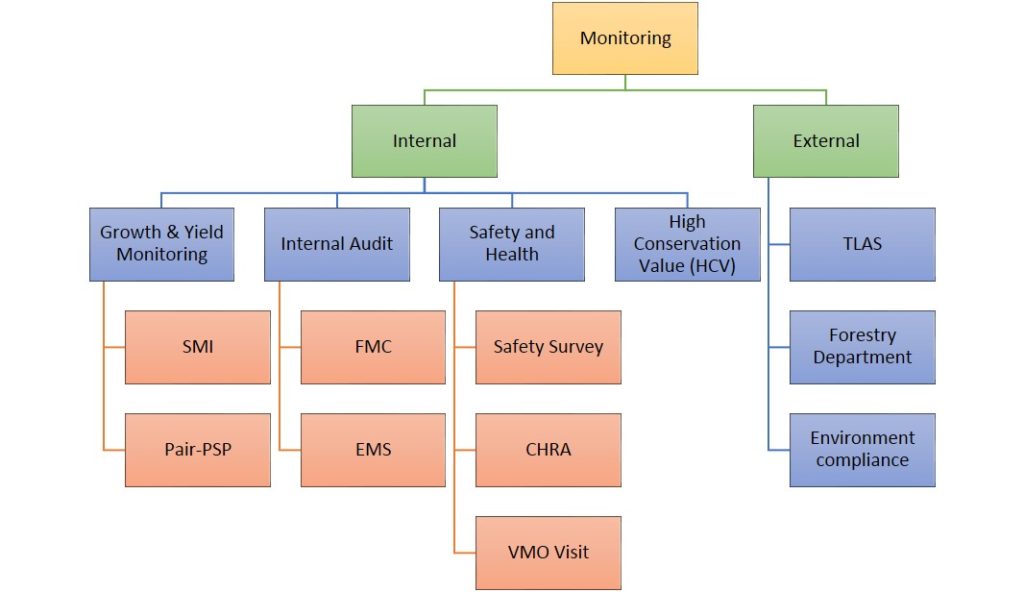
INTERNAL MONITORING PROGRAM
A. Growth and Yield Monitoring
Studies on tree stand quantity and forest growth were carried out as long term objective to formulate a realistic stocking data of Segaliud Lokan Forest Reserve. The study began in 1998 until now and will be continue further. Currently KTS Plantation is adapting two methods for forest resource monitoring;
I. SMI
Objective:
- To estimate the current and future timber stocking in compartment level for FMU 19B
- To determine what are the treatment required in every compartment that could enhance the yield in terms of quality and volume.
- To estimate the potential productivity
II. Pair-PSP:
Objective:
- To monitor and assess the effectiveness of management prescription (Operation Area and Non-Operation Area).
- To determine the mean annual increment (MAI) and annual allowable cut (AAC) for the implementation of Sustainable Forest Management in SLFR.
- To enhance the accuracy of the assessment on the rationale of the harvesting cycle.
- To assess the damage occurs after logging operation in each logged compartment.
Based on SMI data, dipterocarp species make up to 60% of the tree stand, non-dipterocarp makes up to 28% of the composition and pioneer species fill up the rest with 12% tree stand. The average stocking of harvestable trees with DBH 50cm and above ranges from 7.0m3/ha to 22.0m3/ha.
B. Internal Audit
There are two internal audits conducted in KTS Plantation:
- FMC
- EMS
The internal audit for EMS is to ensure conformance to legal requirements and the standard itself. Conducted annually, the audit findings will be documented and discussed in Management Review Meeting.
Internal Audit is an important tool to operationalize the Forest Management Certification Environment Management System in order to have continuous improvement in forest operation and environmental standard.
C. Safety and Health
Safety Survey – Safety Survey is a systematic review to recommend improvements where needed, to provide assurance of the safety of current activities, and to confirm conformance with applicable parts of the safety management system. KTSP safety survey is conducted annually by engaging the KTS group safety and health department. All companies under the KTS group is rated and awarded based on their performance in Safety and Health.
CHRA – The Chemical Health Risk Assessment (CHRA) is an assessment of usage, handling, storage or transportation of chemical hazardous to Health in KTSP as required by the Occupational Safety and Health (Use and Standard of Exposure of Chemical Hazardous to Health) Regulation 2000.
VMO Visit– Due to the absent of Medical Assistant in KTSP, we engaged a Visiting Medical Officer (VMO) from our local clinical panel to monitor the safety and health of our employees. The visit is conducted every 2 month and during the visit, the VMO will review KTSP clinica; and medical record and monitor the base camp area for any safety and health issues in workplace.
D. High Conservation Value Forest (HCVF) Monitoring
KTSP conduct our own monitoring and management for High Conservation Value in Segaliud Lokan Forest Reserve (SLFR) with an advice from stakeholder such as WWF and also with the support of research collaboration from external organizations like UMS, HCVF monitoring is conducted annually ti ensure there is no encroachment to the site that has benn gazetted as HCV.
External Monitoring Program
A. TLAS Audit
KTSP was certified with TLAS Certificate since 2008. Timber Legal Assurance System (TLAS) is a system introduced by Sabah State Government through Sabah Forestry Department (SFD) to ensure all timbers that has been extracted from its land are legal. TLAS audit is conducted by a third party and this year the audit was conducted by Global Forestry Services Sdn Bhd (GFS). The audit is joined by Sabah Forestry Department to monitor the auditing processes and to assists the licensees in providing any information required by the auditing body. Three-way discussions between the licensees, auditors and SFD will verify the compliance to the conditions listed in the system checklist.
KTSP was certified with TLAS Certificate since 2008 and KTS Plantation has complied with TLAS certification for year 2023.
B. Sabah Forestry Department
Forestry department is conducting their own monitoring on every FMUs including in Segaliud Lokan Forest Reserve (SLFR). Here, we have full-time field staff from Pejabat Perhutanan Mukim Segaliud Lokan under the jurisdiction of District Forestry Officer (DFO) Wilayah Sandakan dedicated to promote excellency in the SLFR Forest Management.
C. Environment Compliance
Environment Compliance Report (ECR) is conducted by North Borneo Environmental Services Sdn Bhd (NOBES), a registered consultant with DOE. ECR is submitted to Environment Protection Department (EPD) to report results of environmental monitoring of the operation and implementation of the recommended mitigation measures as identified in Environmental Impact Assessment. It is also one of the methods to evaluate on the compliance with the Environmental Condition as imposed by EPD in the agreement of the Environmental Condition.

